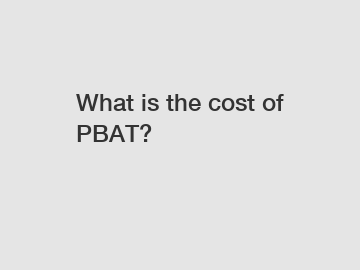What is the cost of PBAT?
What is the cost of PBAT?
Polybutylene adipate terephthalate, commonly known as PBAT, is a biodegradable plastic material that has gained significant attention in recent years. As the demand for sustainable and eco-friendly alternatives to traditional plastics continues to grow, PBAT has emerged as a viable solution. However, one important aspect that needs consideration before adopting PBAT is its cost. In this article, we will explore the various factors that contribute to the cost of PBAT and assess its competitiveness in the market.
Raw Material Prices.

Like other plastic materials, the cost of PBAT is influenced by the prices of its raw materials. PBAT is typically composed of several components, including adipic acid, terephthalic acid, and butanediol. The prices of these raw materials can fluctuate due to various factors such as supply and demand dynamics, production costs, and market trends. These fluctuations can have a direct impact on the cost of PBAT, making it susceptible to market volatility.
Production Technology and Scale.
Another factor that affects the cost of PBAT is the production technology employed by manufacturers. Different production methods may vary in terms of efficiency, energy consumption, and process complexity, which can influence the overall manufacturing cost. Furthermore, the scale of production also plays a significant role. Larger production volumes allow for economies of scale, leading to lower costs per unit. As the demand for PBAT increases, it is expected that economies of scale will be realized, contributing to a potential reduction in its cost.
Biodegradability Additives.
One of the key characteristics of PBAT is its biodegradability. To enhance this property, manufacturers often add specific additives to the material. These additives can include enzymes or other biodegradation-promoting substances. The cost of these additives can contribute to the overall cost of PBAT. However, with advancements in technology and increased demand, it is expected that the price of biodegradability additives will decrease over time, making PBAT more cost-effective.
Market Competition.
The level of competition in the market also influences the cost of PBAT. As more companies enter the PBAT manufacturing sector, competition intensifies, leading to price adjustments. A competitive market encourages companies to find ways to reduce costs and increase efficiency to maintain or gain market share. This competitive pressure can contribute to a potential reduction in the cost of PBAT, making it a more affordable option for various industries.
Application Considerations.
The cost of PBAT can vary depending on the specific application requirements. Certain industries may require PBAT with higher performance characteristics, such as improved mechanical properties or enhanced heat resistance. Meeting these demands may involve additional processing steps or the use of specialized additives, which can increase the overall cost. Conversely, applications that do not require such advanced features may offer a more cost-effective option for PBAT utilization.
Closing paragraph:
In conclusion, the cost of PBAT is influenced by various factors, including raw material prices, production technology, scale, biodegradability additives, market competition, and application considerations. While the current cost of PBAT may be higher than conventional plastics, it is important to consider the long-term benefits that PBAT offers in terms of its environmental impact and sustainability. As the demand for PBAT grows and technology advances, it is expected that the cost will gradually decrease, making PBAT a more economically viable choice. For further information or inquiries about PBAT and its cost, please do not hesitate to contact us.
If you want to learn more, please visit our website custom biodegradable bag Manufacturer, biodegradable resin, biodegradable starch bags.


